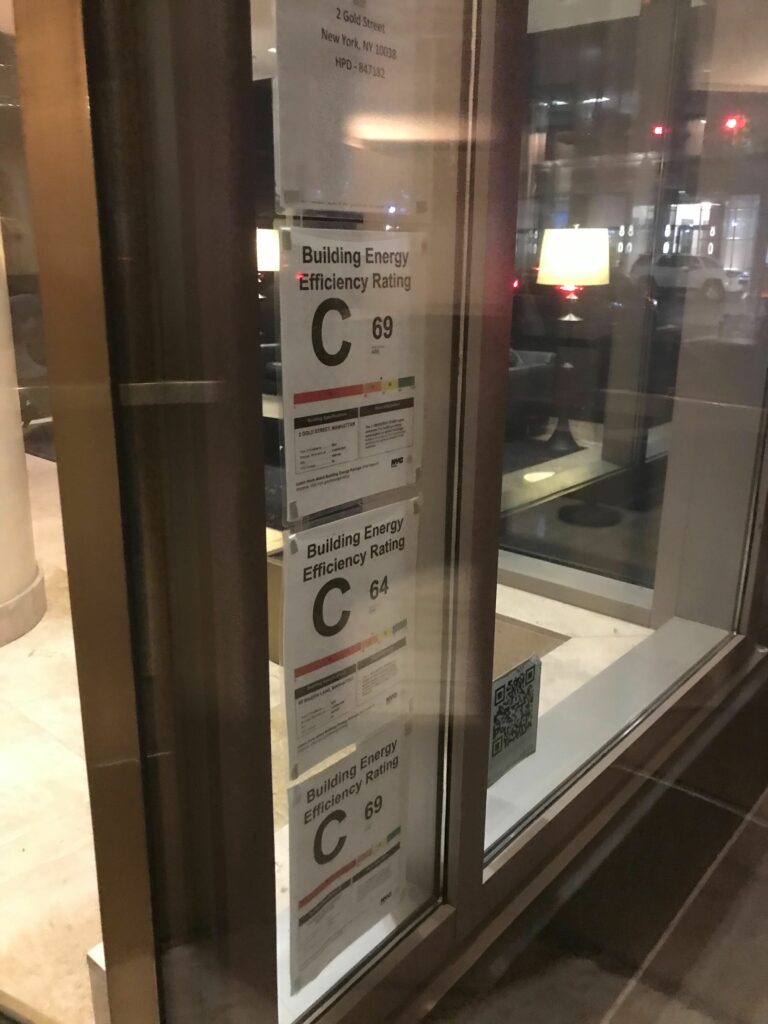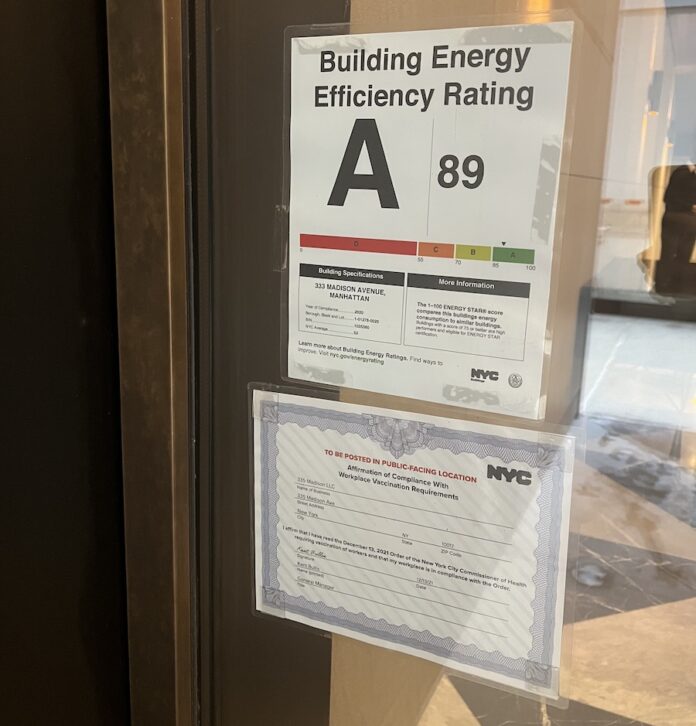The name might seem pretty straightforward. Energy Efficiency Scores grade the energy efficiency of your building. But there’s more to it than just that. Buildings have been receiving energy rankings since 2009, but recent laws have made the process more rigorous and transparent. For the purposes of this article, we’ll focus on the new law that went into effect in 2019, as well as the amendment added for buildings over 25,000 square feet. Local Law No. 95 requires all buildings to have an efficiency rating based on Energy Star and EPA guidelines. In October 2020, an additional rule was added that larger buildings had to have these scores posted on their main entrances.
NYC Energy Efficiency Grading System
First and foremost, how are these New York City buildings being graded? The rankings come from Energy Star and are based on energy consumption, water consumption, and greenhouse gas emissions. Buildings must submit energy information to the government for a 12 month period of time, and a list of fuels burned and converted on site. These criteria add together for a total score of anywhere between 1-100. The grading system is provided by Local Law No.95 and looks like this:
- A: Buildings with a score of 85 or above
- B: Buildings that received a score between 70 and 84
- C: Buildings that received a score between 55 and 69
- D: Buildings that received a score below 55
- F: Buildings that did not submit energy information
- N: Buildings that are exempt or not covered by the Energy Star standards.
This grading system applies to all buildings within Energy Star parameters. But, again, only buildings over 25,000 square feet will require to post grades for the public to see. That’s around 50,000 buildings and nearly two-thirds of the building area in the city.
So, since its implementation in October 2020, how have New York City buildings been ranking? The answer is…not great. Of the approximately 40,000 buildings that submitted reports when the law was first implemented, about half of them received a D. Thousands submitted nothing, receiving F’s. Buildings like The New York Stock Exchange and Trump Tower received some of the lowest scores, while the Flatiron Building and the Empire State Building did rather well. That said, if only a handful of buildings scored high, it doesn’t really mean anything if every other building scored low.

Penalties and the Future
For context, this is part of New York City’s larger plan to cut carbon emissions by 40% by 2030 and 80% by 2050. Given that buildings in the city are responsible for 70% of emissions, it’s no wonder why the grading criteria is so high for these structures. That said, buildings with low scores face no punishment unless they refuse to put up a grade. For the moment, they are simply encouraged to make their buildings more energy-efficient. However, building owners and managers are scrambling because the consequences won’t stay away forever.
In 2024 Local Law No. 97 goes into effect, which would fine buildings with lower scores. Depending on how low the scores are, the buildings could receive fines as high as hundreds of thousands of dollars. This has incentivized many buildings to change their energy consumption and distribution. However, progress on that has even been slow. While the number of D-graded buildings has dropped from approximately 44% to approximately 39% by the end of 2021, this rate of change will not meet the eventual goals set by the mayor’s office. What’s even more troubling, the amount of F grades jumped up by 2% within the same time span, which means even more buildings have failed to even submit data.
The borough with the best growth is Manhattan, which had significantly less A ratings than Brooklyn or Queens. Currently, though, Manhattan’s A-ranked buildings have had an increase of 8%, making it the most official borough in the city. This, in a way, is an easy fix. As the most expensive borough with the most tourism, it’s also the location with the most money. Other boroughs simply don’t have the resources to compete, so they could use a bit more support from the city’s government.
How To Make A Building More Energy Efficient
Additionally, there are cheaper ways to make a building more energy-efficient. Buildings can use better insulation in order to reduce heat. They can also use energy-efficient lighting or even invest in cogeneration systems that collect heating waste and convert it into energy. However, all of these take time and money, and, especially for pre-war buildings, completely replacing systems is tricky, considering it means extensive renovations for every apartment. People who own their apartments can do many of these things on their own, but it will take a group effort to raise an efficiency score above a C, and not everyone in the city has that kind of time and effort.

So far the grades are doing what they were intended to do, which is to publicly display how inefficient some buildings were and incentivize owners to make changes. However, if real change is going to occur, the city will need a more concrete plan of attack than hoping building owners and managers will be shamed into action, especially considering thousands aren’t even submitting information on energy consumption at all.
The goal of energy-efficient buildings is a noble one that New York City should absolutely be striving for. Recognizing which practices and buildings are damaging is a big step, and some changes have been made. However, much more needs to be done to reach the reduction goals set by the mayor’s office. It will take time, effort, and real consequences to owners who don’t comply with guidelines. This task will not be easy, but it is a noble and necessary cause that cannot be put on the back burner. Until then, talk to your building management if your complex has a low score. See what efforts they are making, and ask how you can help out. After all, no one wants to live in a D building.
Russell is a writer and comic based in New York City. His plays have been featured at Penn State’s Cultural Conversation’s Festival, The NYC Thespis Festival, and Imaginarium’s Inaugural Theater Festival. Follow him on TikTok and Instagram @pooleparty528



